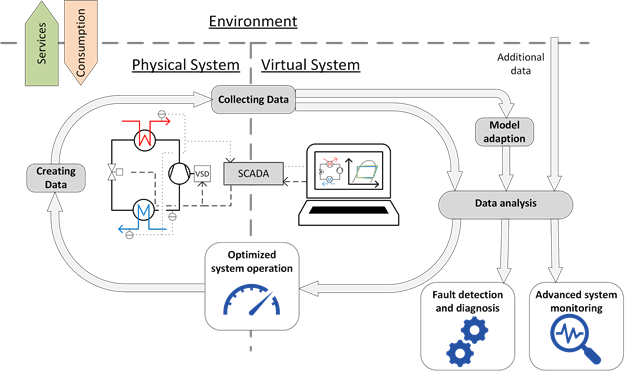
The concept of digital twins
A virtual representation of heat pump or refrigeration systems to gain increased insights, which constitute the basis for offering improved or additional services.
Digital twins are a set of numerical models, which mimic the real, physical system. They are continuously adapting to the current status of the system to ensure an ongoing accuracy with regard to the system status. The numerical models may be based on different approaches and differ in complexity. Currently, the creation of digital twins is associated with a considerable effort, which prevents their wide adoption in this kind of applications. Therefore, this project focuses on decreasing the effort for creating digital twins by developing service-oriented models, which fulfill the intended services while being modular, reusable, and with limited complexity.
The operating plant is producing much data, which is mainly used to ensure the provision of the key services such as heating and cooling. However, through sophisticated analyses, it is intended to valorize this data in order to provide additional or improved services. This is done by analyzing the the data in various ways, including the direct analysis as well as a model-based analysis. In addition, the use of numerical models allows for the consideration of external data forecasts such as weather data, and consumer profiles of variable electricity tariffs.

Figure 1: Digital twin concept for large-scale heat pump and refrigeration systems.
The data analyses create additional insights about the system and how to use it, which is the basis for exploiting the technical potential most optimally with respect to various services:
- Advanced system monitoring
- Fault detection and diagnosis
- Optimized system operation
The optimized system operation has a direct feedback on the plant operation and thereby a direct feedback on the creation of new measurement data.
The digital twins may be located and structured on different levels. This comprises data handling on sensor and actuator level, system level, or cloud level.